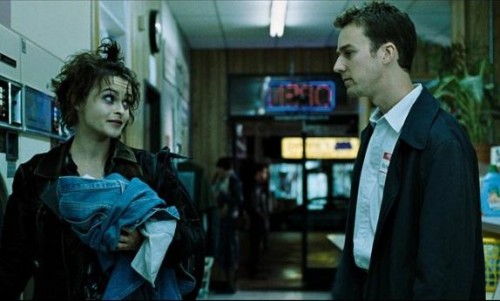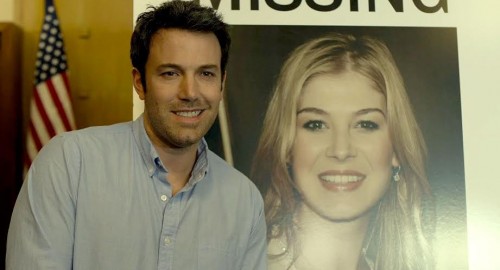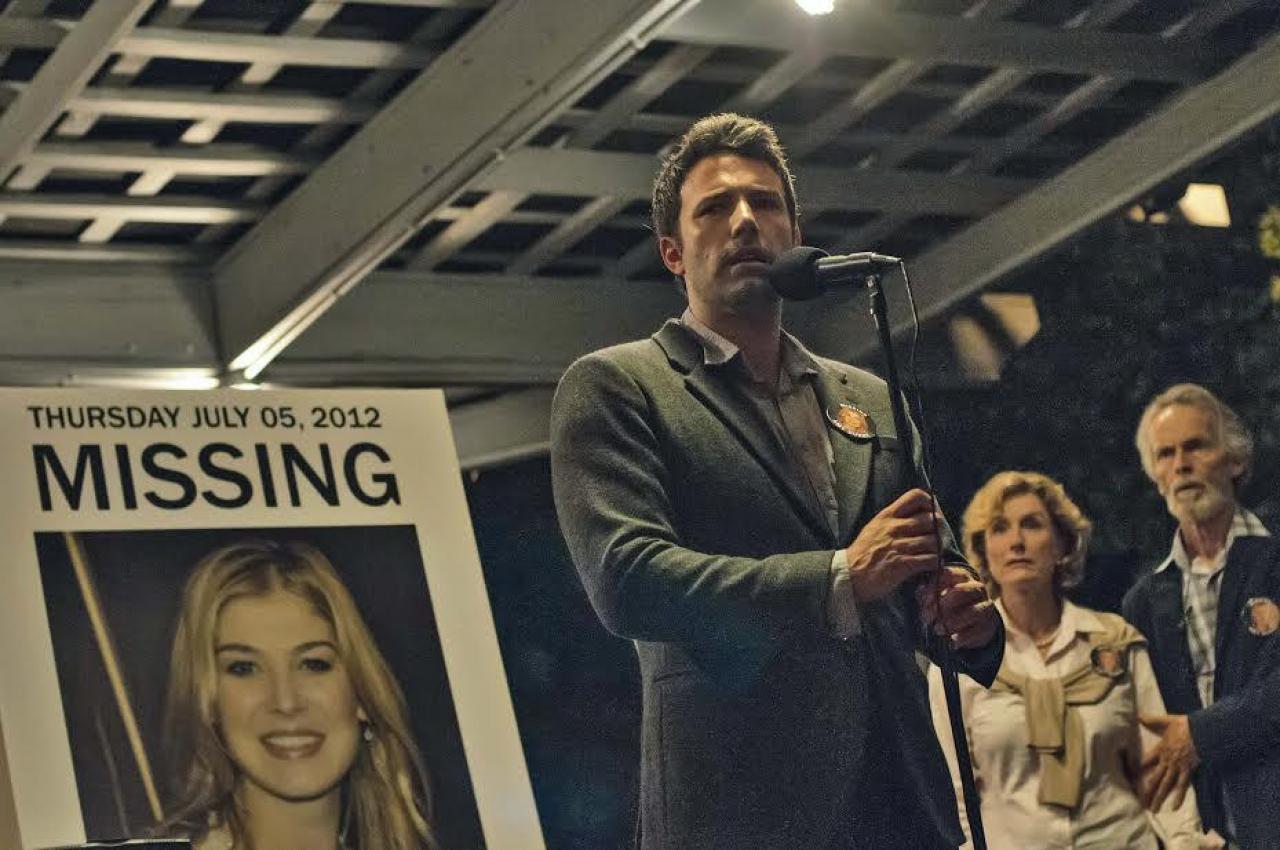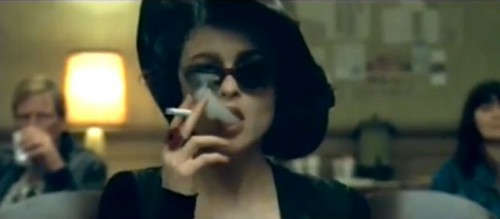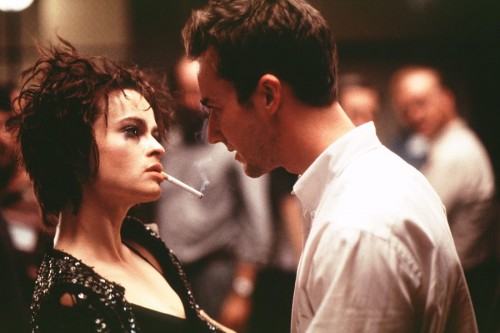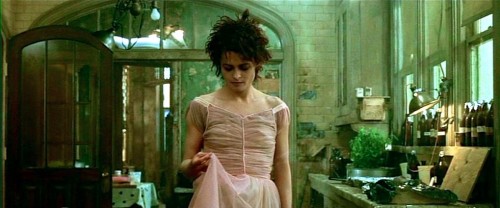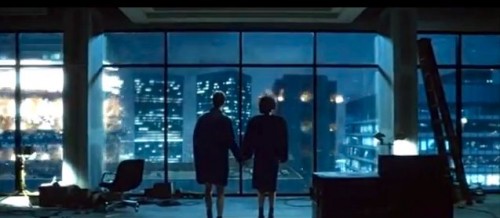This is a guest post by Brigit McCone.
Although it opens boldly with the statement “all of this: the guns, the bombs, the revolution… has got something to do with a girl named Marla Singer,” the romance plot of David Fincher’s cult masterpiece Fight Club (1999) is rarely treated as central. Partly, this reflects our cultural bias that the love interest of a male film (particularly one chock-full of testosterone) is incidental, where the love interest of a female film must be integral. Yet, perhaps, the most gleefully subversive statement of this gleefully subversive film is that it ultimately adds up to “Zen Buddhist Romantic Comedy. FOR MEN!” It is in this light that I would like to analyze Fight Club: as a classic romantic comedy structured by the template of Jane Austen’s Pride and Prejudice, and a drama of closeted sexuality on the template of Oscar Wilde’s The Picture of Dorian Gray. Restoring the female and gay male origins of the film’s themes may raise interesting questions about the ways we interpret such similar subject matter so differently, depending on the speaker.
“This is cancer, right?”: The Meet-Cute
The meet-cute of Pride and Prejudice occurs at its first ball. Elizabeth Bennet, a character established by a series of laughing jokes and superior judgements at the expense of society around her, is dismissed in a single sentence by the superior and judgmental Mr. Darcy: “She is tolerable, I suppose, but not handsome enough to tempt me.” The friction is established: it is the characters’ unbearable similarity that creates the irresistible irritation between them, sustained through tense debate and a famous dance as they struggle to resist each other. For Elizabeth, Darcy is that little scratch in the roof of her mouth that would heal, if only she could stop tonguing it. This was Austen’s great romcom innovation: where previous romance plots treat external problems as the only obstacles to true love, Austen’s protagonists are separated by their own flaws and lack of self-knowledge. Unlike Shakespeare’s The Taming of the Shrew, in Pride and Prejudice there can be no question of one character’s submission, as they are the image of each other and their challenge is rather to submit to greater awareness of themselves. It is not surprising that a woman writer would develop the theme of similarity between male and female as the basis of attraction, where the male had a greater vested interest in asserting the charm of female weakness and subordination as the foundation of successful love. Fight Club, however, follows the feminine Austen mould. Our painfully unaware protagonist meets Marla memorably at a testicular cancer support group. The smoking woman’s unfitness to be there is as flamingly obvious as Darcy’s overbearing ego, while our hero’s secret, fraudulent testicular completeness is as carefully concealed as Elizabeth Bennet’s superiority complex. The narrator may even perceive himself to be faking while actually suffering from the same crippling emasculation as the group. Either way, it is the similarity between these two that drives their mutual irritation and banter for the first section of the film.
“I am Jack’s Raging Bile Duct”: Protagonist Rejects Love Interest
The first turn in the relationship comes when Marla reveals vulnerability by phoning the protagonist during a suicide attempt. He apparently rejects her, only to find the charismatic Tyler Durden has answered the call and bedded the girl. Feeling like “Jack’s Raging Bile Duct” gives our first hinted admission of the hero’s desire for Marla, but this period is marked by his sustained emotional and sexual rejection of her, based on his misunderstanding that she desires Durden, when Durden is in fact (SPOILER) an imaginary character created by our hero’s psychosis. Romantic misunderstanding caused by mental illness puts Fight Club in the tradition of Benny & Joon, As Good As It Gets, or even the spectrum of obsessive compulsive and neurotic behaviors displayed by the typical Meg Ryan protagonist. In other words, Fight Club’s use of dissociative identity disorder as romcom obstacle is an extreme example of a canonical romcom trend; it is personality flaw as romantic rival and allows Norton to spend the film’s middle section beating himself up for failing to be Brad Pitt. The effect is to shift the romantic relationship from a mutual friction towards the pursuit of a resistant, misunderstanding protagonist by an emotionally vulnerable love interest. Or, in other words, the same effect Austen generates by the misunderstandings that climax in Darcy’s proposal and rejection.
“You’re the worst thing that ever happened to me”: Love Interest Rejects Protagonist
The second turn comes when Norton’s character realizes the source of the misunderstanding and his true feelings for Marla. By then, however, his cumulative mistakes make the relationship unsalvageable and Marla takes a bus out of his life. This may be compared with Darcy’s abandonment of Elizabeth following her sister’s elopement, as the moment at which “all hope is gone” and the heroine fully realizes her romantic desire only as the love interest seemingly leaves forever. For Elizabeth, this acceptance of Darcy as love object parallels her own acceptance of herself as flawed and arrogant, just as Norton’s character is only able to care for Marla through the recognition and acceptance of his flaws, crippling dissociative identity disorder among them.
“My eyes are open”: Sacrificing the Ego
Jane Austen had a dilemma. Her mirroring love interests, Darcy and Elizabeth, each needed to sacrifice their egos to be together. Darcy had achieved this by proposing to Elizabeth. Yet, the restraints placed on female behavior in the 19th century, which reduced woman to passive love object in most plots, prohibited Austen’s heroine the romantic agency required to sweep her man off his feet. So, she cheated. Introducing the figure of Lady Catherine DeBourgh as a test of pride, Austen required Elizabeth to resist denying her feelings for Darcy in the face of intense provocation. In effect, Lady Catherine allows Elizabeth to propose by proxy while suffering public humiliation. This public humiliation/proposal would become the clichéd heart of “the airport dash” in romcom lore. Fight Club offers an original spin. Our hero shoots himself in the face, a public disfigurement as well as painful sacrifice, to destroy the alter-ego who is a visible embodiment of the most toxic aspects of his pride. In that state of bloody vulnerability, Marla finds herself unable to reject him and the two hold hands as the phallic towers crumble before them.
“I”m free in all the ways that you are not”: The Closeting Drama
Apart from the central romance, there are two major concerns in Fight Club: philosophical debate between Norton’s hero and Tyler Durden, and the depiction of Durden’s dangerously seductive, corrupting influence on the wider world. The Picture of Dorian Gray opens with lengthy philosophical debate between Basil Hallward, the vulnerable, sincere artist and lover, and Henry Wotton, the cynical, corrupting wit and charmer. Their friendship seems odd, as Hallward disapproves of Wotton and Wotton scorns Hallward. In Fight Club, the relationship between the hero and his Durden is made clear: Tyler, with the face of “millionaire, movie god” Brad Pitt, is free in all the ways the hero is not, yet trapped by the hero’s imagination. Wilde explained the strangely static relationship between Hallward and Wotton in a similar way: “Basil Hallward is what I think I am; Lord Henry what the world thinks me.” In other words, Lord Henry is Hallward’s Durden: a romantically impervious, socially masterful alter-ego who effortlessly dominates and corrupts society, while Hallward is Wilde’s most open portrait of homosexual romantic vulnerability. The main thrust of The Picture of Dorian Gray is a war between alter-egos Wotton and Hallward for the soul of the vulnerable Dorian Gray. The main thrust of Fight Club is a war between alter-egos Tyler Durden and Jack’s Inflamed Sense of Rejection for the soul and body of the vulnerable Marla Singer.
Although this comparison illuminates Fight Club as closeting drama, in this case the closeting of male insecurity and romantic vulnerability, the contrasts say as much as the parallels. In The Picture of Dorian Gray, Hallward, whose feelings for Dorian are presented as noble, romantic and capable of saving him, is viewed by Dorian with pity and contempt for expressing a “friendship so coloured by romance,” then savagely stabbed to death, his social isolation affirmed by the fact that nobody notices his absence – the reels have changed but the film carries on with Wotton in the driving seat. The book shows the total corruption of Hallward’s loving image of Dorian (the portrait itself) and the triumph of the cynical values of Wotton at the expense of both the vulnerable, true self, and of the love interest. Where love dare not speak its name, the mask must devour the face. Fight Club takes its modern, heterosexual manhood on a journey from emasculating self-loathing and testicular cancer to violent nihilism and rebellion but, ultimately, reveals the source of their grievance to be a figment of their own imagination. The painful split between inadequate hero and super-cool alter-ego is shown to be farcically self-imposed when Marla dismisses the godlike Durden as “Mr. Jackass.” Where Dorian chooses Wotton, Marla Singer has chosen Jack’s Raging Bile Duct all along. The romantic reconciliation which concludes Fight Club was literally impossible for Wilde’s novel, already savaged by censors, which neatly illustrates the contrast between the self-imposed crisis of modern masculinity and the socially imposed crisis of gay identity in the past. It is Wotton and Hallward’s “Dorian Gray Club” that one does not talk about, and Fight Club that is free in all the ways Dorian Gray is not.
“I can’t get married, I’m a 30-year-old boy”: Recognizing Male Romantic Comedy
Male romantic comedy has always been a major part of the genre: consider Frank Capra’s It Happened One Night, Billy Wilder’s The Apartment, Hal Ashby’s Harold and Maude, or Woody Allen’s Annie Hall.These works generally enjoyed greater critical esteem than that accorded to female romcom directors such as Elaine May, Nora Ephron, Amy Heckerling, Darnell Martin, Sharon Maguire, Gurinder Chadha, or Nancy Meyers. Now, critical successes As Good As It Gets and Fight Club join a golden age of male romantic comedy: There’s Something About Mary, Eternal Sunshine of the Spotless Mind, Shallow Hal, The 40-Year-Old Virgin, Knocked Up, (500) Days of Summer, Hitch, Zack and Miri Make a Porno, Wedding Crashers, Silver Linings Playbook, I Love You Phillip Morris, and Don Jon to name a few. And yet, in recent times, we have seen articles such as Tatiana Siegel’s 2013 piece for the Hollywood Reporter lamenting the “death” of the romantic comedy. What happened to the romcom? Apparently, men started to enjoy them. Should we feel flattered by this male appreciation of a genre created in its modern form by women like Jane Austen? Or insulted that male appreciation of the romcom can only occur by refusing to appreciate it as romcom? “You show me your sensitive side, then you turn into a total asshole.” Is that a pretty accurate description of the attraction and sneering rejection of the male audience for romcom?
Recognizing male romantic comedy as classic romcom is not only vital for a fuller appreciation of male romantic vulnerability, but also of female romantic comedy and gay male social comedy as more than “mere” romance and frivolity. As much as Fight Club, The Picture of Dorian Gray is a blistering critique of a decadent society that rewards toxic masculinity at the expense of true intimacy. As much as Fight Club, Pride and Prejudice is a psychological journey and a protagonist’s confrontation with and reconciliation with their own self. And, as much as any female romcom, Fight Club is a romance. And a damn funny one.
Brigit McCone has a degree in Russian and Drama, writes and directs short films and radio dramas and is the author of The Erotic Adventures of Vivica under her cabaret pseudonym Voluptua von Temptitillatrix. Her hobbies include doodling and irritating Fight Club fanboys.
